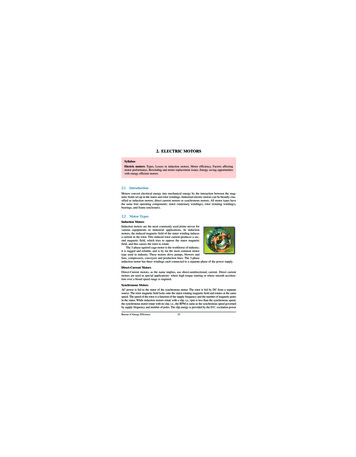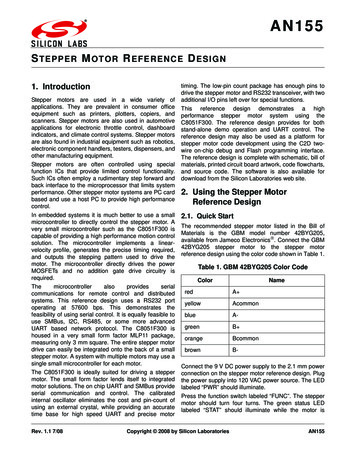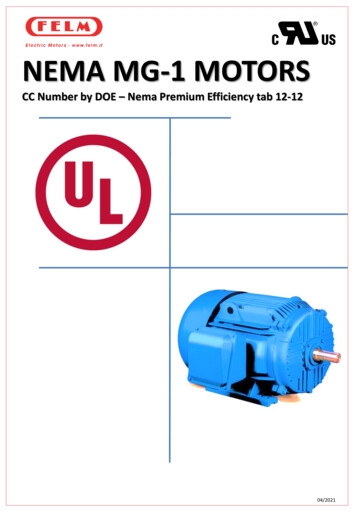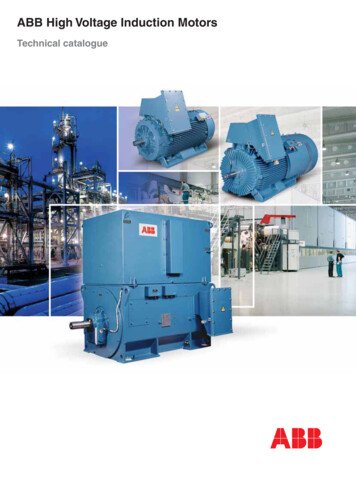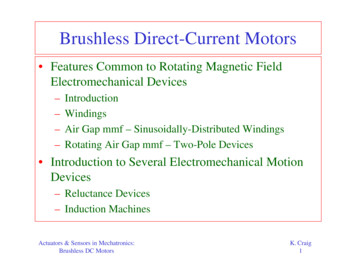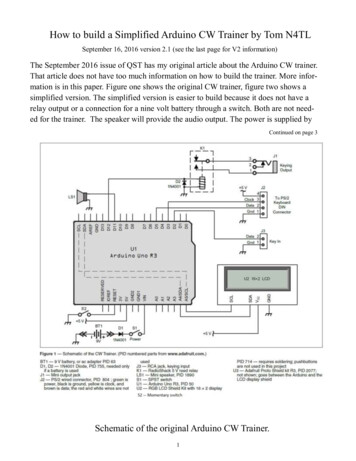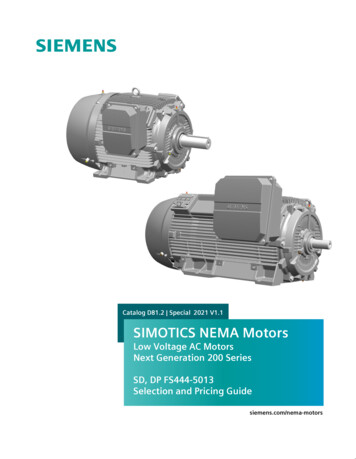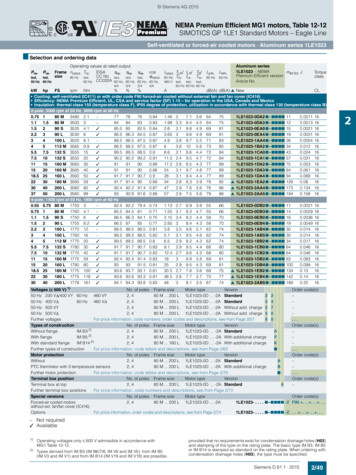
Transcription
All About Stepper MotorsCreated by Bill otorsLast updated on 2021-11-15 06:12:15 PM EST Adafruit IndustriesPage 1 of 21
Table of ContentsWhat is a Stepper Motor?3 A 4-phase unipolar motor.4Types of Steppers5 Motor SizeStep CountGearingShaft StyleWiringCoils and PhasesUnipolar vs. Bipolar5-Wire Motor6-Wire Motor8-Wire Motor677891010111111Driving a Stepper12 Simple Unipolar DriverSimple Dual H-Bridge DriverAdafruit Motor Shield V2Advanced CNC ControllersMatching the Driver to the Stepper Know the Driver SpecificationsKnow the Motor SpecificationsObey the Law!Running Above the Law?Chopper Drives13131415161617171819FAQ19Resources21 Adafruit IndustriesPage 2 of 21
What is a Stepper Motor?Stepper motors are DC motors that move in discrete steps. They have multiple coilsthat are organized in groups called "phases". By energizing each phase in sequence,the motor will rotate, one step at a time.With a computer controlled stepping you can achieve very precise positioning and/orspeed control. For this reason, stepper motors are the motor of choice for manyprecision motion control applications.Stepper motors come in many different sizes and styles and electrical characteristics.This guide details what you need to know to pick the right motor for the job. Adafruit IndustriesPage 3 of 21
A 4-phase unipolar motor.Animation from Wikimedia CommonsWhat are stepper motors good for? Positioning – Since steppers move in precise repeatable steps, they excel inapplications requiring precise positioning such as 3D printers, CNC, Cameraplatforms and X,Y Plotters. Some disk drives also use stepper motors toposition the read/write head. Speed Control – Precise increments of movement also allow for excellentcontrol of rotational speed for process automation and robotics. Low Speed Torque - Normal DC motors don't have very much torque at lowspeeds. A Stepper motor has maximum torque at low speeds, so they are agood choice for applications requiring low speed with high precision. Adafruit IndustriesPage 4 of 21
What are their limitations? Low Efficiency – Unlike DC motors, stepper motor current consumption isindependent of load. They draw the most current when they are doing nowork at all. Because of this, they tend to run hot. Limited High Speed Torque - In general, stepper motors have less torque athigh speeds than at low speeds. Some steppers are optimized for betterhigh-speed performance, but they need to be paired with an appropriatedriver to achieve that performance. No Feedback – Unlike servo motors, most steppers do not have integralfeedback for position. Although great precision can be achieved running‘open loop’. Limit switches or ‘home’ detectors are typically required forsafety and/or to establish a reference position.Types of SteppersThere are a wide variety of stepper types, some of which require very specializeddrivers. For our purposes, we will focus on stepper motors that can be driven withcommonly available drivers. These are: Permanent Magnet or Hybrid steppers, either2-phase bipolar, or 4-phase unipolar. Adafruit IndustriesPage 5 of 21
Motor SizeOne of the first things to consider is the work that the motor has to do. As you mightexpect, larger motors are capable of delivering more power. Stepper motors come insizes ranging from smaller than a peanut to big NEMA 57 monsters.Most motors have torque ratings. This is what you need to look at to decide if themotor has the strength to do what you want.NEMA 17 is a common size used in 3D printers and smaller CNC mills. Smaller motorsfind applications in many robotic and animatronic applications. The larger NEMAframes are common in CNC machines and industrial applications.The NEMA numbers define standard faceplate dimensions for mounting the motor.They do not define the other characteristics of a motor. Two different NEMA 17 motorsmay have entirely different electrical or mechanical specifications and are notnecessarily interchangeable. Adafruit IndustriesPage 6 of 21
Step CountThe next thing to consider is the positioning resolution you require. The number ofsteps per revolution ranges from 4 to 400. Commonly available step counts are 24, 48and 200.Resolution is often expressed as degrees per step. A 1.8 motor is the same as a 200step/revolution motor.The trade-off for high resolution is speed and torque. High step count motors top-outat lower RPMs than similar size. And the higher step-rates needed to turn thesemotors results in lower torque than a similar size low-step-count motor at similarspeeds.GearingAnother way to achieve high positioning resolution is with gearing. A 32:1 gear-trainapplied to the output of an 8-steps/revolution motor will result in a 256 step motor.A gear train will also increase the torque of the motor. Some tiny geared steppers arecapable of impressive torque. But the tradeoff of course is speed. Geared steppermotors are generally limited to low RPM applications.Backlash is another issue with geared motors. When the motor reverses direction, itneeds to take up any slack there may be in the gear-train. This can affect positioningaccuracy. Adafruit IndustriesPage 7 of 21
Shaft StyleAnother thing to consider is how the motor will interface with the rest of the drivesystem. Motors are available with a number of shaft styles: Round or "D" Shaft: These are available in a variety of standard diameters andthere are many pulleys, gears and shaft couplers designed to fit. "D" shafts haveone flattened side to help prevent slippage. These are desirable when hightorques are involved. Geared shaft: Some shafts have gear teeth milled right into them. These aretypically designed to mate with modular gear trains. Lead-Screw Shaft: Motors with lead-screw shafts are used to build linearactuators. Miniature versions of these can be found as head positioners in manydisk drives. Adafruit IndustriesPage 8 of 21
WiringThere are many variations in stepper motor wiring. For our purposes, we will focus onsteppers that can be driven with commonly available drivers. These are PermanentMagnet or Hybrid steppers wired as 2-phase bipolar, or 4-phase unipolar. Adafruit IndustriesPage 9 of 21
Coils and PhasesA stepper motor may have any number of coils. But these are connected in groupscalled "phases". All the coils in a phase are energized together.Unipolar vs. BipolarUnipolar drivers, always energize the phases in the same way. One lead, the"common" lead, will always be negative. The other lead will always be positive.Unipolar drivers can be implemented with simple transistor circuitry. Thedisadvantage is that there is less available torque because only half of the coils canbe energized at a time.Bipolar drivers use H-bridge circuitry to actually reverse the current flow through thephases. By energizing the phases with alternating the polarity, all the coils can be putto work turning the motor.A two phase bipolar motor has 2 groups of coils. A 4 phase unipolar motor has 4. A 2 Adafruit IndustriesPage 10 of 21
phase bipolar motor will have 4 wires - 2 for each phase. Some motors come withflexible wiring that allows you to run the motor as either bipolar or unipolar.5-Wire MotorThis style is common in smaller unipolarmotors. All of the common coil wires aretied together internally and brought outas a 5th wire. This motor can only bedriven as a unipolar motor.6-Wire MotorThis motor only joins the common wiresof 2 paired phases. These two wires canbe joined to create a 5-wire unipolarmotor.Or you just can ignore them and treat itlike a bipolar motor!8-Wire MotorThe 8-wire unipolar is the most versatilemotor of all. It can be driven in severalways: 4-phase unipolar - All the commonwires are connected together - justlike a 5-wire motor. 2-phase series bipolar - The phasesare connected in series - just like a6-wire motor. 2-phase parallel bipolar - Thephases are connected in parallel.This results in half the resistanceand inductance - but requires twicethe current to drive. The advantageof this wiring is higher torque andtop speed. Adafruit IndustriesPage 11 of 21
Driving a StepperStep in time, step in timeCome on, mateys, step in timeStep in timeStep in time, step in timeStep in time, step in timeNever need a reason, never need a rhymeWe step in time, we step in time"Step In Time"Robert B. Sherman and Richard M. ShermanDriving a stepper motor is a bit more complicated than driving a regular brushed DCmotor. Stepper motors require a stepper controller to energize the phases in a timelysequence to make the motor turn. Adafruit IndustriesPage 12 of 21
Simple Unipolar DriverThe simplest type of driver can be built with a handful of transistors. These are simplyswitched on and off in sequence to energize the phases and step the motor. Unipolardrivers are relatively inexpensive to build, but only work with unipolar motors. There isan excellent tutorial on how to build one at the Arduino site.Unipolar Stepper Drive Tutorialhttps://adafru.it/doaSimple Dual H-Bridge DriverDriving a bipolar motor requires 2 full H-bridges so it can reverse the current to thephases. H-bridges can be tricky to build from scratch. But there are plenty of H-bridgechips available to simplify the task. Adafruit IndustriesPage 13 of 21
The L293D is one of the most popular and economical chips. These can be found atthe heart of most first-generation motor shields, including the incredibly popular V1Adafruit Motor Shield.There is an excellent tutorial on using a bare L293D with an Arduino in the AdafruitLearning System:Lesson 16 - Stepper Motorshttps://adafru.it/dobAdafruit Motor Shield V2The Adafruit Motor Shield V2 is a big step up from the basic L293D based controllers.The V2 shield uses two TB6612 MOSFET drivers. Compared to the L293D, theTB6612 offers twice the current capacity and much lower voltage drops to drive yoursteppers more efficiently.With 2 driver chips and 4 full H-bridges total, each shield can drive up to two steppermotors. The driver chips are interfaced via a dedicated PWM driver chip with an I2Cinterface. This frees up lots of GPIO pins for other uses, and makes the shieldstackable too. You can stack up to 32 of them to control 64 motors with just 2 IO pins!Compete details of this driver can be found in the Learning system.Adafruit Motor Shield V2 Guide Adafruit IndustriesPage 14 of 21
https://adafru.it/docAdvanced CNC ControllersThe gShield and TinyG CNC controller boards take you one step closer to industriallevel stepper performance. These boards feature constant-current "chopper" driversthat can be tuned to deliver maximum torque and speed from your motors.The TinyG CNC features an on-board G-code interpreter and 4 motor outputs makingthis a complete embedded solution for a small to medium sized 4-axis CNC machine.As you might expect, these advanced, high-performance boards are more complex towork with and are recommended for experienced users.Details on these boards and their operation can be found in the TinyG Wiki and theSynthetos Forums.Synthetos Forumshttps://adafru.it/dodTiny G Wikihttps://adafru.it/doe Adafruit IndustriesPage 15 of 21
Matching the Driver to the StepperNow we come to the most important part: making sure that your motor and driver arecompatible.Mismatched motors and drivers can result in disappointing performance. Or worse:damage to the motor and/or controller.If you choose unwisely, you might meet this guy:Know the Driver SpecificationsThe two most important parameters in the driver specificatons are: Voltage - The maximum voltage that the driver can supply to the motor. Adafruit IndustriesPage 16 of 21
Continuous Current - The maximum current that the driver can supply to themotor."Peak" current ratings are not applicable to stepper motors. Always go by the"continuous" current rating.Know the Motor SpecificationsYou will also need to know the electrical specifications for the motor. There are 2critical parameters: Amps per phase - This is the maximum current that the motor windings canhandle without overheating. Resistance per phase - This is the resistance of each phase.A Voltage rating is often stated. It is usually calculated from the two above - but notalways. It is better to calculate yourself from the above parameters using Ohm's Law.Obey the Law!Stepper motor phases are inductors, so they will resist rapid changes in current flow.But at the end of each step or when not moving, they behave like a purely resistiveload and will behave according to Ohm's Law (https://adafru.it/doB).Standing still is also when a stepper motor draws the most current. So Ohm's Lawallows us to use the motor specifications to calculate the current requirements of thedriver.Voltage Current x ResistanceorCurrent Voltage / Resistance Adafruit IndustriesPage 17 of 21
These formulas should be strictly applied for all "constant voltage" steppercontrollers. This includes both V1 and V2 Motor Shields from Adafruit, andvirtually all other L293D based controllers.But some motors have very low coil resistance. Strictly following those formulas, thedrive voltage will be less than 5v and performance will not be good. This type ofmotor is not a good match for a constant-voltage driver. These steppers require amore specialized controller.Running Above the Law?It is not possible to cheat Ohm's Law. If you try, you will have to answer to the BlueSmoke Monster. However, there are some other laws at work here. The expertise atthe law firm of Lenz, Faraday and Ohm can help you to increase the performance ofyour motor.The stepper coils create a magnetic field when they are energized. According to Faraday's Law (https://adafru.it/doD), the changing magnetic field induces a current in thecoil. And according to Lenz's Law (https://adafru.it/doA), that current will be in thereverse direction of the current creating the field. This reverse current is known as"Back Electromotive Force" or "Back EMF".This Back EMF increases the "impedance" or effective resistance of the coil. So Ohm'sLaw (https://adafru.it/doB) still applies - but to this impedance, not to the simple phaseresistance. This impedance limits the current flow through the coil at the beginning ofeach step. Adafruit IndustriesPage 18 of 21
Chopper DrivesA Chopper or "Constant Current" drive compensates for the back EMF by driving themotor with a higher voltage. It is not unusual to drive stepper motors at several timestheir rated voltage using a chopper drive.To keep things safe at these higher voltages, the chopper drive also monitors thecurrent being delivered to the motor and "chops" it before it exceeds a pre-set level.By starting at a higher voltage, the chopper drive is able to deliver more current to thecoils at the start of the step, increasing the available torque. In addition to addingtorque at slower speeds, this also allows for higher top-speeds.Selecting a chopper driver and configuring it for a specific motor requires a goodunderstanding of both the motor and the controller.FAQWill this motor work with my shield?You need to know the motor specifications as well as the controller specification.Once you have that information, check the "Matching the Driver to the Stepper"page to see if they are compatible. Adafruit IndustriesPage 19 of 21
It's a NEMA 17, so it should work, right?NEMA frame-size standards only define the dimensions of the mounting faceplate.To figure out if it is compatible, you need to know the electrical specifications ofthe motor.What if there are no motor specifications?See Jason on reverse engineering the stepper wire pinouts (https://adafru.it/aOI).That will tell you the phase resistance. For phase current, you can estimate basedon motors of similar design and similar phase resistance.When in doubt, it is always better to err on the safe side and use a lower current!What size motor do I need for my project?Most motors have torque (https://adafru.it/doj) specifications - usually in inch/ounces or newton/centimeters. One inch/ounce means that the motor can exert aforce of one ounce at one inch from the center of the shaft. For example, it couldhold up one ounce using a 2" diameter pulley.When calculating the torque required for your project, be sure to allow extra torquerequired for acceleration (https://adafru.it/dok) and to overcome friction. It takesmore torque to lift a mass from a dead stop than it does to simply hold it up.If your project requires a lot of torque and not much speed, consider a gearedstepper.How do I connect my motor to the Motor Shield?For motors purchased from Adafruit, there are wiring instructions listed in theproduct descriptions.For other motors, check the motors spec sheet if available.If you don't have a spec sheet, check Jason on reverse engineering the stepperwire pinouts (https://adafru.it/aOI).Will this power supply work with my motor?First make sure it does not exceed the voltage rating for the motor or thecontroller.* You can usually run a motor at a lower voltage, although you will get Adafruit IndustriesPage 20 of 21
less torque.Next, check the current rating. Most stepping modes energize two phases at atime, so the current rating should be at least twice the current per phase for yourmotor.*ResourcesThere is a lot of excellent information on the web about stepper motors. Here aresome of our favorite links: Wikipedia (https://adafru.it/aOF)Stepper Motor Page (https://adafru.it/aOF) RepRap Stepper Motor Page (https://adafru.it/dol) Jones on Stepper Motors (https://adafru.it/aOH) Jason on reverse engineering the stepper wire pinouts (https://adafru.it/aOI) Adafruit IndustriesPage 21 of 21
Nov 15, 2021
